My parents are verrrry picky eaters who eat primarily home cooked, gourmet Indian food, so I was beyond thrilled when they devoured this vegan dal makhani. And since I’ve gotten so many requests for a vegan dal makhani recipe in the last year, I figured it was about time to share one with you!
This recipe is a labor of love and is not a weeknight, Westernized version of an Indian recipe. That’s because traditional Indian recipes are not quick; they layer so many different spices and flavors, and cooking them together takes time to meld into a harmonious dish that will delight your tastebuds.
So, if you’re looking for authentic, gourmet, restaurant-quality Indian food that will blow your mind, this recipe is a must-make. The flavors are complex and linger on the tongue, and the texture is unctuous, velvety, and luxurious. It’s a whole experience. And an even better one when paired with my homemade vegan naan (it’s fluffy, pillowy, chewy, and buttery!).
If you have an Instant Pot, I highly recommend making the Instant Pot version because it’s much quicker and just as tasty! And you can find several more Indian and Indian-inspired Instant Pot recipes in my cookbook, The Vegan Instant Pot Cookbook.

What is Dal Makhani?
In India, dal refers both to the ingredient–pulses, such as lentils, split peas, chickpeas (chana), kidney beans, and more–as well as the dish. If you want to read more about dal and the different pulses used in dal, please read my Restaurant-Style Dal Tadka blog post.
There are everyday dals, the kind I ate most nights as a kid. And then there are dals for fancy times, and Dal Makhani squarely falls into the latter camp. It’s incredibly rich and sumptuous and quite possibly my favorite dal.
Dal Makhani is a North Indian dal that originated in the Punjab region of modern-day India and Pakistan. It was officially “invented” by well-known chef and restaurateur Kundan Lal Gujral in the mid-20th century, but has origins dating further back (read more about the history of Dal Makhani here).
Fun fact: Dal Makhani has the same flavors as the popular “butter chicken” (i.e., murgh makani).
Dal Makhani is made with (1) whole urad dal (also known as black gram). Whole urad dal look like black lentils and are often marketed as such, but they’re not actually lentils. They’re the seeds of a leguminous plant called Vigna mungo, and have a thin black coating and an inner white seed.
Many recipes, including mine, also include a small amount of (2) kidney beans, commonly referred to as rajma.
The pulses (i.e., lentils and beans) are simmered with spices, aromatics, and tomatoes for several hours, or even overnight. The slow simmering is what lends the creamy, viscous texture. It also features a generous amount of butter and cream (makhan = “butter” in Hindi). Traditionally, it’s simmered in a tandoor (clay) oven or in big pots over large wood fires, which lend a slightly smoky flavor.
Keep on reading to learn how to make authentic-style but vegan Dal Makhani at home (including how to achieve that subtle smoky taste without using a tandoor oven!).
Want more gourmet veganized Indian recipes? Don’t skip these!
– Aloo Gobi: Roasted potatoes and cauliflower are coated in a fragrant and flavorful masala.
– Palak “Paneer”: An easy but gourmet plant-based take on palak paneer that’s indulgent but nourishing.
– Tofu Tikka Masala: A creamy and complex spin on chicken tikka masala that’s wow worthy.
– Malai Kofta: Crispy dumplings in a creamy, spiced curry. Perfect celebratory dish!

How to make Vegan Dal Makhani
Note: you can find Instant Pot instructions in the recipe card below.
Start by rinsing the dried whole urad dal and kidney beans several times, scrubbing them as you go. This helps remove some of the color from the black “lentils” so the end color of the dal is a nice reddish-brown color, and any debris.
Add to a large bowl, cover with a few inches of water, and add a teaspoon of baking soda. Soak 8 hours, or overnight. Drain the pulses and rinse several times until the water runs clear.

Add the pulses to a saucepan, cover with water, and season with salt. Boil for 10 minutes; reduce heat to a simmer, and simmer for 80 to 90 minutes until both are very soft.
Note: if using the Instant Pot method, you need to soak the beans but you can skip this step of pre-cooking the beans.

Fit a colander over a bowl and drain the pulses, reserving the cooking liquid. Measure out the cooking liquid and add enough water to make 3 1/2 to 4 cups. Roughly mash the pulses with a potato masher, large wooden spoon, or fork.

Heat a deep sauté pan over medium-high heat with a bit of oil. Once hot, add the whole spices (cinnamon stick, cloves, cardamom, cumin seeds, bay leaf). Toast briefly until aromatic.
Add the finely diced onion and cook until lightly browned, 5 to 7 minutes.


Add the ginger and garlic and cook for 1 minute, stirring frequently.
Stir in the ground spices (coriander, nutmeg, Indian red chile powder), salt, pepper, and tomato paste. Cook down for 60-90 seconds, stirring frequently.

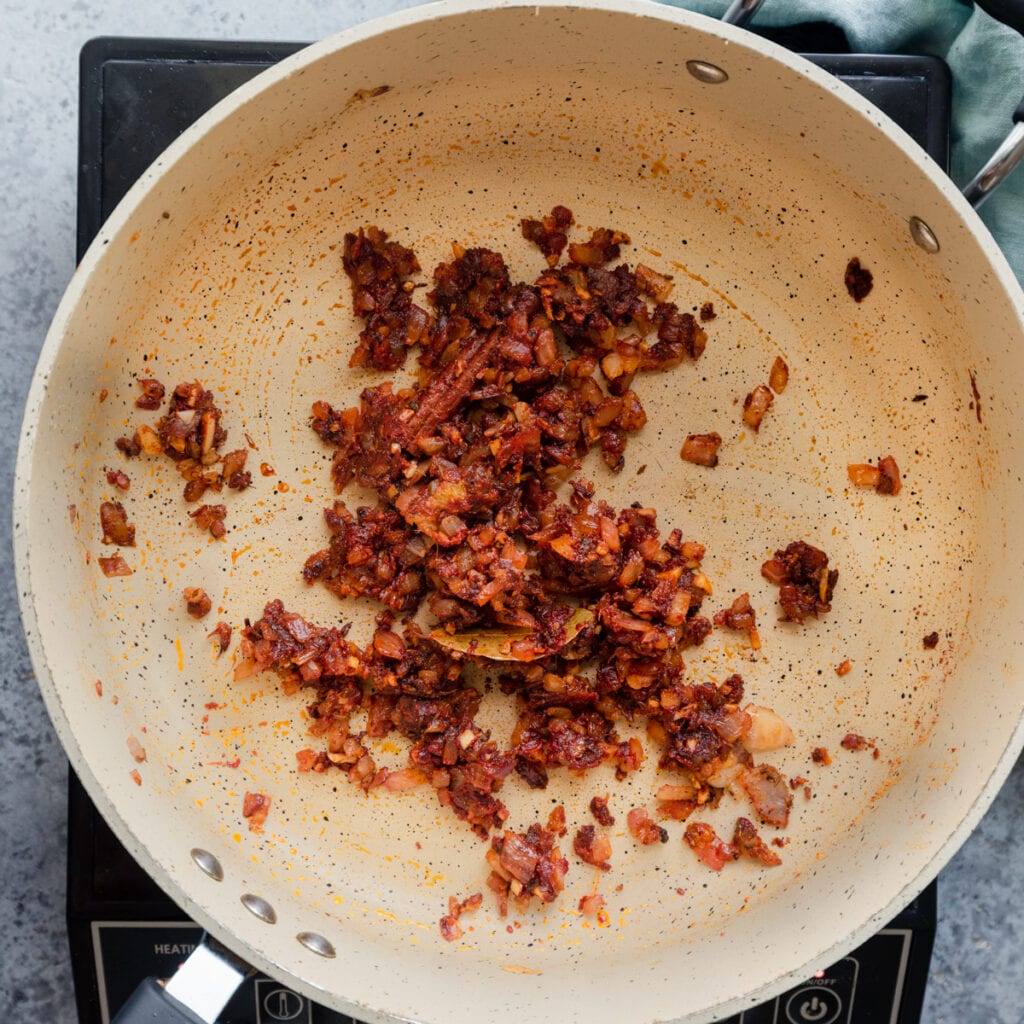
Add the diced tomatoes (and their juices). Cook for 2-3 minutes until softened.
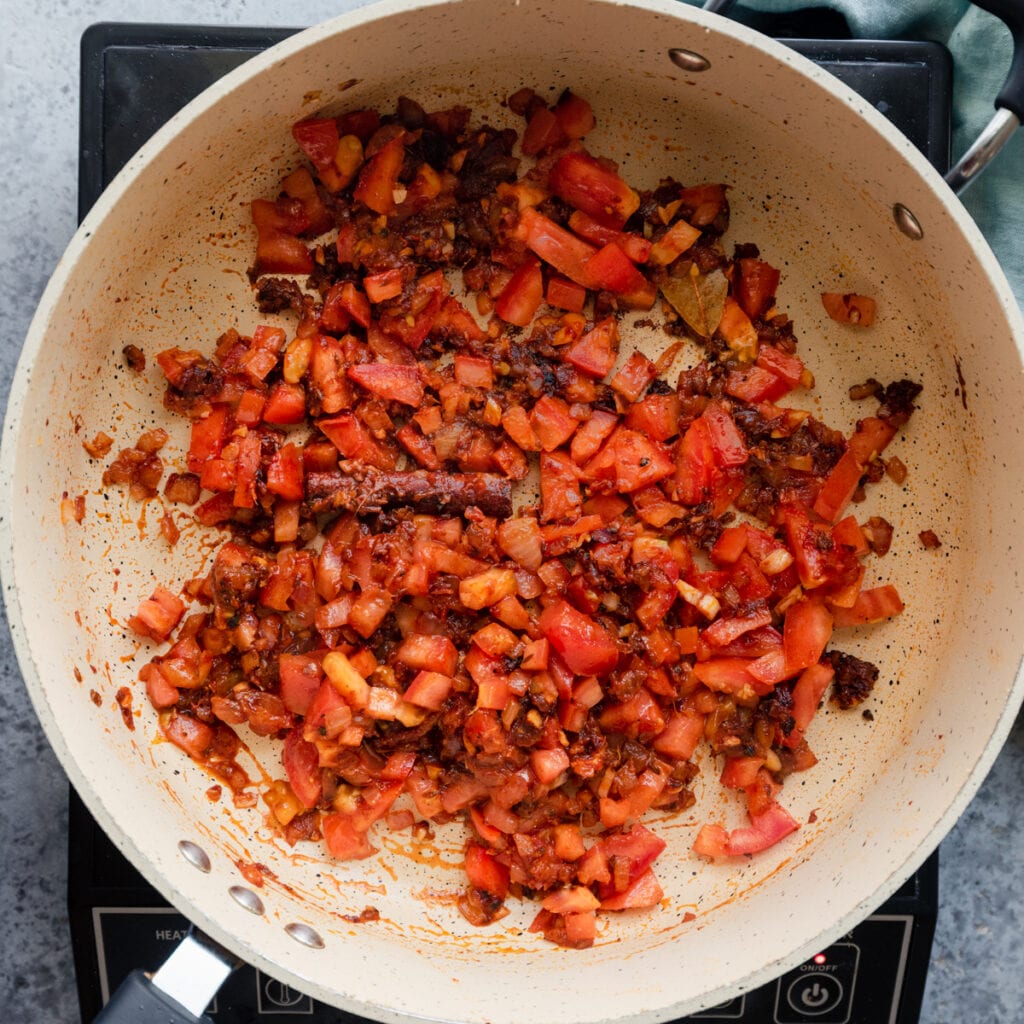

Pour in the bean liquid/water, mashed pulses, and bring the mixture to a boil.

Once boiling, reduce to a gentle simmer and simmer for 70 to 90 minutes, stirring every 10ish minutes. If it starts to dry up, add freshly boiled water from a kettle.
This is what it looked like after 45-50 minutes.

This is what it looked like after 80ish minutes.

Once the dal is quite thick, add the coconut milk or cashew cream. Simmer for another 10 minutes, stirring once or twice to prevent sticking.
The dal should be very creamy by now. If it’s too thick for your liking, stir in a bit of freshly boiled water.

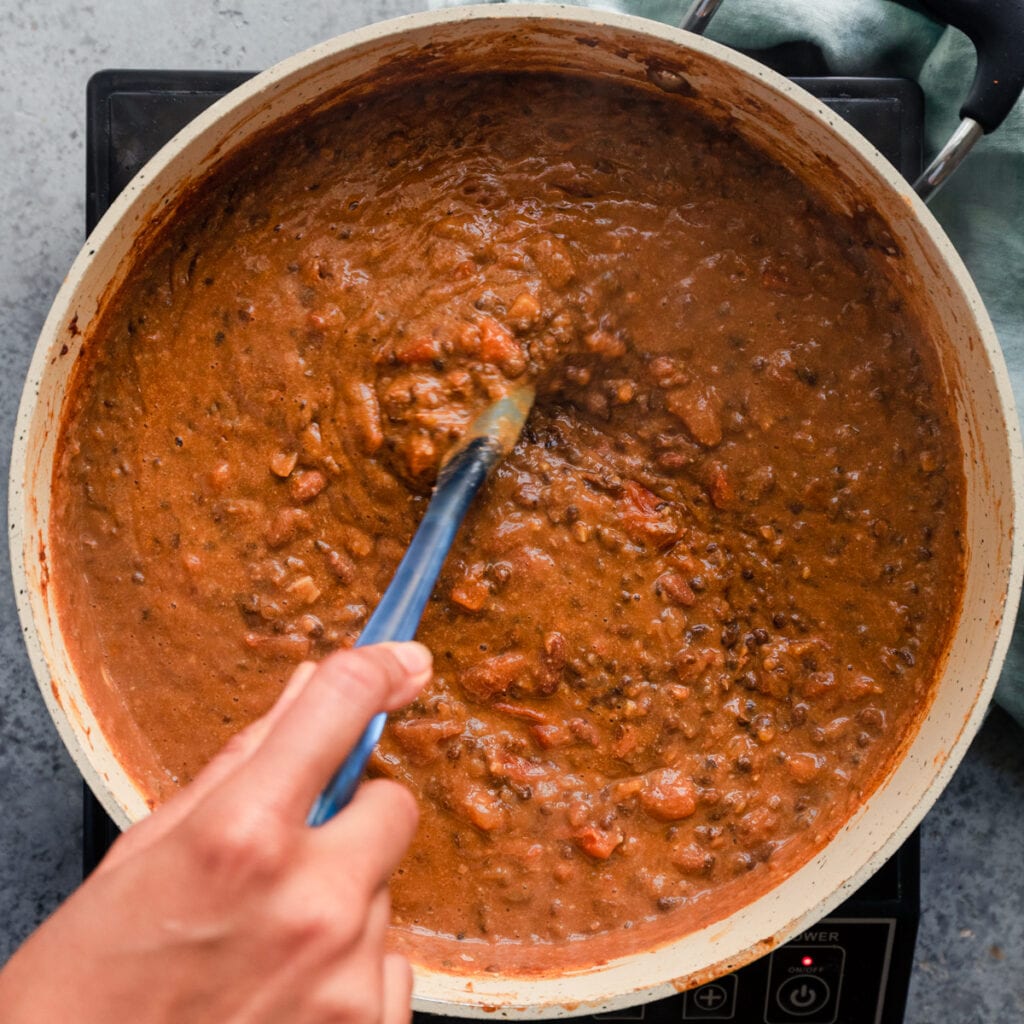
Smoke the dal (optional). See the next section for instructions on the Dhungar method.
Stir in the chopped cilantro and lemon juice, and taste for seasonings, adding salt as needed. Fish out the cinnamon stick and bay leaf.


Make the tadka. Heat the vegan butter in a frying pan over medium-high heat.
Once melted and frothy, crush the kasoori methi (i.e., fenugreek leaves) with your hands into the dal, and add the garam masala and Indian red chile powder. Stir and swirl the pan frequently for 30 seconds, then take off the heat.


Pour the tadka on top of the dal and stir in.

How to infuse a smoky taste into Dal Makhani
Dal Makhani is traditionally cooked in a clay oven or over a wood fire, which brings a smoky taste. To replicate that at home, I use the dhungar method, a South Asian technique of coal smoking food. The smoky flavor is subtle but makes the dal even more irresistible and gives it that je ne sais quoi.
Dhungar method instructions
- Position a small glass or stainless steel bowl in the middle of the cooked dal. If you don’t have either, slice an onion along its orbit and hollow out one half. Use the cavity as your bowl.
- Take a 1- or 2-inch piece of all-natural lump charcoal (you can buy this at many grocery stores and hardware stores). Using tongs, hold the charcoal directly over an open flame (I use my gas burner). Rotate it occasionally and cook for a total of 2 to 3 minutes, until red hot in some spots and a few white markings appear on the charcoal.
- Note: I don’t recommend heating the charcoal for more than 3ish minutes, especially if this is your first time doing this. During one of my many recipe tests, I heated the charcoal for 5 minutes and the smoky taste overpowered the dish.
- Working as quickly as you can, transfer the hot charcoal to the small bowl in the dal and drizzle 1/2 teaspoon of oil onto the charcoal. The charcoal will start smoking immediately (see the below photo). Cover the pan to trap the smoke and let it infuse the dal for 2 to 3 minutes. Discard the charcoal.
For more visual details, please watch the YouTube video (or below) around the 06:00 mark.
If you don’t want to do this step, rest assured, this dal is still very delicious! You can also try adding ½ to 1 teaspoon smoked paprika to the ground spices for a smoky taste.
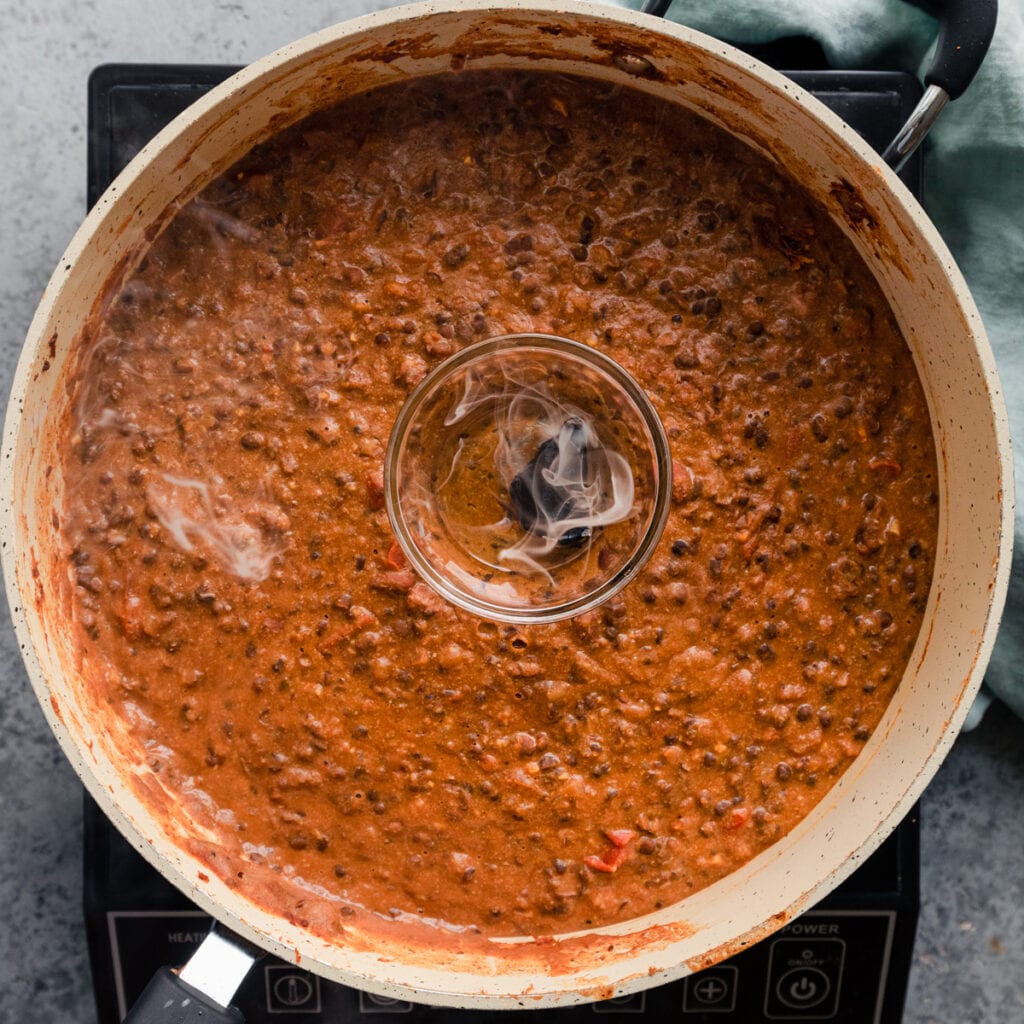
Ingredient Notes and Substitutions
Kidney Beans. If you are cooking the stovetop version and want to speed it up a bit, you can (a) omit the kidney beans and use an additional 1/4 cup of whole urad dal; or (b) use canned kidney beans.
If using canned kidney beans, a few changes: (1) when cooking the whole urad dal, you don’t need to boil it for 10 minutes, and the dal will get soft in a shorter period of time, about 40 to 60 minutes (instead of 80 to 90 minutes); (2) use about 3/4 to 1 cup of canned kidney beaans; (3) roughly mash the beans before adding them to the pot when you add the cooked urad dal and liquid.
Whole urad dal. While these are often referred to as black lentils, they are not lentils and are quite different from the black lentils used in Western cooking (e.g., black beluga lentils). When cooked, black beluga lentils do not get creamy, and therefore aren’t the best option for this sumptuous dal.
If you have a South Asian grocery store in your area, I encourage you to visit it and buy whole urad dal (and lots of spices!). You’ll be supporting what is most likely a family-run small business, the prices are much better than at Western grocery stores, and you’ll be able to enjoy this dish as it’s meant to be.
That said, if you really want to make this dish but don’t have a South Asian grocery store nearby and don’t want to purchase them online, you can substitute a different lentil, like black beluga or green/brown lentils. Again, they don’t soften in the same way, so you’ll get a less creamy result. To rectify some of that, you might want to use less liquid.
PS: you’re looking for whole urad dal (split urad dal is white and smaller).

Whole Urad Dal
Also known as black gram. An essential ingredient in Dal Makhani.
Cashew cream vs. coconut milk. Since Dal Makhani typically has cream, the best vegan substitutes are cashew cream and full-fat canned coconut milk (you don’t need much, just 1/2 cup), from a fat content and a creaminess content. I’ve tried this recipe with both and it’s really tasty either way.
I do particularly love it with cashew cream. The neutral yet nutty flavor of cashews works so well with the Indian spices and lentils (cashews are fairly common in Indian cuisine), and the creamy texture is even better than coconut milk.
Of course, making cashew cream requires you to get a blender dirty and soak some cashews (or least boil them for 15 minutes). Since this dish is requires a long simmer time, I just make the cashew cream during the simmering. But, if you want to do less work, use the coconut milk.
Vegan butter. Again, traditional Dal Makhani is known for its butter, so I use a few tablespoons of vegan butter. If you prefer to not use vegan butter, you can sub a neutral-flavored oil (though you won’t have the exact same rich, buttery mouthfeel).

Tips for making Vegan Dal Makhani
Be patient, or use your Instant Pot. As mentioned, slow simmering is what yields that unctuous, luscious texture, so this dish can’t be rushed (at least on the stovetop).
If you want to make this recipe much more quickly, use the Instant Pot method. You don’t need to pre-cook the pulses, the pressure cook time is 35 minutes, and it’s hands off, so you don’t have to stir ever so often. And the results are remarkably similar in texture and taste.
If making the stovetop method and you don’t want to cook everything all in one day, you can pre-cook the beans and lentils 1 to 2 days in advance.
When pre-cooking the dried kidney beans, be sure to let them boil (not just simmer) for the first 10 minutes. Kidney beans contain lectin, a protein that’s hard to break down in digestion. If kidney beans are eaten undercooked, they can cause you to get quite sick.
When pre-cooking the whole urad dal and kidney beans on the stove, if the water starts to evaporate quite a bit, add freshly boiled water from a kettle to keep them covered. If you leave the pot for 90 minutes and don’t check on it at all (like I did a few weeks ago), the beans and lentils will burn and will be unusable. Same thing for the dal makhani itself – if it starts to dry out, stir in some freshly boiled water.
When making the stovetop version, I find that it’s necessary to de-seed the whole cardamom pods. Otherwise, you might get one big concentrated taste of cardamom in a single bit, or chew on a pod. If making the Instant Pot version, just keep the pods whole (the high pressure will disintegrate and evenly mix them).
This dal gets really creamy, but if you want it to be even thicker, use an immersion blender through a third or a half of the dal after adding the cashew cream/coconut milk.

Frequently Asked Questions
With rice or an Indian flatbread (or a combination of both, if you really love carbs like I do lol). I always serve my dals with basmati white rice, but you could do brown rice for a nutrition boost.
As for Indian flatbread, my vegan naan is an epic pairing. For something quicker, you can find vegan naan at Whole Foods, Sprouts, and Trader Joe’s. They’re certainly not as good as homemade, but if you lightly char them over an open flame and brush them with the vegan garlic butter in my homemade naan recipe, it’ll make them a lot better.
This dal will stay good in the fridge for 3 to 5 days.
Yes! I like to freeze in smaller portion so they defrost more quickly.
If you are making this ahead of time, just make the dal and freeze as it – don’t add the tadka at the end. Instead, when ready to serve, make the tadka fresh.
To reheat, you can pop it in the microwave, or heat over medium heat on the stove. If it thickens quite a bit, just add a bit of water while heating.

Watch! How to make Dal Makhani
If you try this epic vegan Dal Makhani recipe and love it, please be sure to rate and review it below!
Vegan Dal Makhani
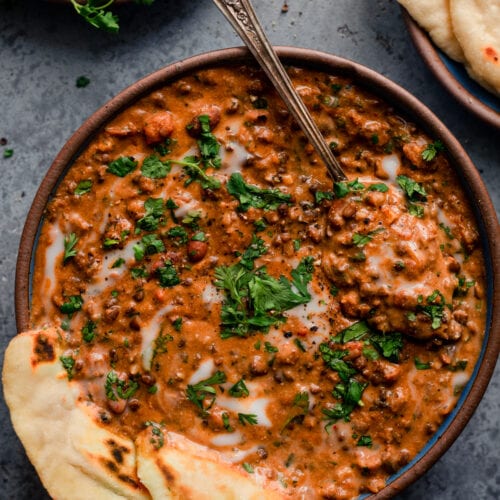
Ingredients
- 1 cup (205g) whole urad dal (aka black gram)*
- ¼ cup (44g) dried kidney beans**
- 1 teaspoon baking soda
Whole Spices
- 1 ½ tablespoons grapeseed oil or neutral oil
- 1 2 to 3-inch cinnamon stick
- 4 green cardamom pods, seeds only (¼ heaping tsp of seeds)
- 3 whole cloves
- 1 bay leaf
- 1 teaspoon cumin seeds
Aromatics and Ground Spices
- 1 medium-large red onion, very finely diced
- 1-inch piece fresh ginger, minced or grated
- 4 garlic cloves, finely chopped
- 2 tablespoons tomato paste
- ⅛ teaspoon nutmeg (I prefer freshly grated, but ground is fine)
- 1 teaspoon coriander
- ½ teaspoon Indian red chile powder**** (1 tsp for a spicier version; 1/4 tps for a mild version)
- 2 teaspoons kosher salt*****
- Freshly cracked black pepper
- 2 medium tomatoes (8-10 oz, 230-280g), diced
Other ingredients
- 3 ½ to 4 cups (840-960 mL) liquid (water + bean cooking liquid)
- ½ cup (120 mL) Cashew Cream (recipe below) or full-fat coconut milk***
- 1 cup (12g) cilantro leaves and tender stems, chopped
- 1 tablespoon lemon juice, plus more as needed
- ½ to 1 teaspoon organic cane sugar (as needed)
Dhungar method (for smokiness; optional)
- 1 to 2- inch piece of lump charcoal
- ½ teaspoon neutral-flavored oil
Tadka
- 3 tablespoons (42g) vegan butter
- 1-inch piece ginger, peeled and cut into matchsticks (optional; only if you love ginger)
- 1 tablespoon kasoori methi, crushed with your hands
- 1 teaspoon garam masala
- ½ teaspoon Indian red chile powder
Cashew Cream (optional)
- 1/2 cup (70g) raw cashews
- 6 tablespoons (90 mL) water, more as needed
- 1 tablespoon freshly squeezed lemon juice
- 1/2 teaspoon kosher salt
Instructions
- Rinse the whole urad dal and kidney beans and scrub them with your hands; drain the water and repeat this process a few times.
- Cover the lentils and beans with a few inches of cold water. Add the baking soda. Soak for 8 hours (or overnight). Drain and rinse several times, until the water runs clear. Note: you can quick soak them by covering them with boiling water for 4 hours.
- Cook the lentils and beans. Transfer them to a medium saucepan and cover with 1 to 2 inches of water and ½ teaspoon kosher salt. Cover and bring to a boil, skimming off the foam that rises to the surface once it starts to boil. Boil uncovered for 10 minutes, then reduce the heat to maintain a simmer and simmer for 80 to 90 minutes until the beans and lentils are very soft. If the water evaporates during simmering, add freshly boiled water as needed.
- Fit a bowl underneath a colander and drain the lentils and beans, saving the cooking liquid. Measure out the cooking liquid and add enough water to make 3 1/2 cups (4 cups for a slightly looser dal). Mash the lentils and beans with a potato masher, fork, or large wooden spoon. Set both aside for now.
- Start cooking the dal. Heat the 1 ½ tablespoons oil in a deep saute pan or Dutch oven over medium-high heat. Once hot, add the cinnamon stick, cardamom, cloves, bay leaf, and cumin seeds. Cook for 45 to 60 seconds, swirling the pan frequently, until aromatic and sizzling.
- Add the onions with a pinch or two of salt. Cook, stirring occasionally, until the onions are starting to brown, 5 to 7 minutes. Add in a few splashes of water towards the end to pick up the fond and to prevent them from getting too brown.
- Add the garlic and ginger, and cook for 1 minute, tossing frequently. Add the tomato paste, nutmeg, coriander, red chile powder, 1 1/2 to 2 teaspoons of kosher salt, and pepper to taste. Stir frequently for 60 to 90 seconds. Add the tomatoes and their juices, and cook until broken down and softened, 2-3 minutes.
- Pour in the bean liquid/water mixture and scrape up any browned bits to deglaze the pan. Add the mashed lentils and beans, and stir well.
- Bring to a boil, then reduce the heat to maintain a simmer. Stir every 10 minutes for at least 60 minutes, or up to 80 minutes (slow cooking enhances the flavors and makes it extremely creamy). During simmering, add more freshly boiled water, as needed, if it looks like it’s drying up.
- Pour in the cashew cream or coconut milk and simmer for another 10 minutes, stirring occasionally to prevent sticking.
- Dhungar Method (optional, for smokiness). Take a small stainless steel or glass bowl and position it in the middle of the cooked dal. If you don't have such a bowl, take a medium onion and cut it in half, around the orbit. Hollow out one half.
- Using tongs, take a 1 to 2 inch piece of lump charcoal and hold it directly over an open flame (I use my gas burner). Rotate it from time to time and heat for 2 to 3 minutes, until it turns red hot in spots and has a few white markings. Note: I don't recommend heating it for more than 3ish minutes, as the smoky flavor can become overpowering.
- Working as quickly as you can, transfer the charcoal to the small bowl and pour ½ teaspoon of neutral flavored oil on top of the charcoal (it will start smoking immediately). Cover the pan with the lid and steam for 2 to 3 minutes. Remove the lid and use tongs to remove the small bowl. Discard the charcoal. Stir the dal again.
- Add in the cilantro and lemon juice and season to taste with salt. If it’s a bit too acidic for your taste, add the sugar. Fish out the cinnamon stick and bay leaf.
- Make the tadka. Heat the vegan butter in a medium frying pan on the stove over medium high heat. Once melted, add the ginger (if using) and cook for 30 seconds, stirring frequently. Crush the kasoori methi with your hands into the dal, and add the garam masala and red chile powder. Cook for another 30 seconds, swirling the pan frequently. Pour the tadka over the dal and serve.
- If making the cashew cream. Cover the cashews with some water in a saucepan. Bring to a boil and boil for 15 minutes. Drain and rinse cashews (Or soak overnight in cool water). Transfer the drained cashews to a food processor. Add the water, lemon juice, and salt. Blend for 3-4 minutes, scraping down as you go, until all cashews are pulverized and the mixture is smooth.Note: you can double this recipe and make it in a high-powered blender (the amount here doesn't have enough liquid for most blenders)
Notes
Instant Pot Vegan Dal Makhani

Ingredients
- 1 cup (205g) whole urad dal (aka black gram)*
- ¼ cup (44g) dried kidney beans**
- 1 teaspoon baking soda
Whole Spices
- 1 ½ tablespoons grapeseed oil or neutral oil
- 1 2 to 3-inch cinnamon stick
- 4 green cardamom pods, lightly cracked
- 3 whole cloves
- 1 bay leaf
- 1 teaspoon cumin seeds
Aromatics and Ground Spices
- 1 medium-large red onion (8-10 oz, 230-280g), very finely diced
- 1- inch piece fresh ginger, minced or grated
- 4 garlic cloves, finely chopped
- 2 tablespoons tomato paste
- ⅛ teaspoon nutmeg (I prefer freshly grated, but ground is fine)
- 1 teaspoon coriander
- ½ teaspoon Indian red chile powder**** (1 tsp for a spicier version; for a mild version, use ¼ tsp)
- 1 1/2 to 2 teaspoons kosher salt*****
- Freshly cracked black pepper
- 2 medium tomatoes (8-10 oz, 230-280g), diced
Other ingredients
- 2 ½ cups (600 mL) water
- ½ cup (120 mL) cashew cream (recipe below) or full-fat coconut milk***
- 1 cup (12g) cilantro leaves and tender stems, chopped
- 1 tablespoon lemon juice plus more as needed
- ½ to 1 teaspoon organic cane sugar as needed
Dhungar method (for smokiness; optional)
- 1 to 2- inch piece of lump charcoal
- ½ teaspoon neutral-flavored oil
Tadka
- 3 tablespoons (42g) vegan butter
- 1- inch piece peeled ginger, cut into matchsticks (optional; only if you love ginger)
- 1 tablespoon kasoori methi, crushed with your hands
- 1 teaspoon garam masala
- ½ teaspoon Indian red chile powder
Cashew Cream (optional)
- 1/2 cup (70g) raw cashews
- 6 tablespoons (90 mL) water, more as needed
- 1 tablespoon freshly squeezed lemon juice
- 1/2 teaspoon kosher salt
Instructions
- Rinse the whole urad dal and kidney beans and scrub them with your hands; drain the water and repeat this process a few times.
- Cover the lentils and beans with a few inches of cold water. Add the baking soda. Soak for 8 hours (or overnight). Drain and rinse several times, until the water runs clear. Note: you can quick soak them by covering them with boiling water for 4 hours.
- Select the Sauté setting on the Instant Pot. Add 1 1/2 tablespoons oil, and once the oil is hot, add the cinnamon stick, cardamom pods, cloves, bay leaf, and cumin seeds. Cook for 45 to 60 seconds, stirring frequently, until aromatic and sizzling.
- Add the onions with a pinch or two of salt. Cook, stirring occasionally, until the onions are starting to brown, 5 to 6 minutes. Add in a few splashes of water towards the end to pick up the fond and to prevent them from getting too brown.
- Add the garlic and ginger, and cook for 1 minute, tossing frequently. Add the tomato paste, nutmeg, coriander, red chile powder, 1 1/2 to 2 teaspoons of kosher salt, and pepper to taste. Stir frequently for about 1 minute. Add the tomatoes and their juices, and cook until broken down and softened, 2-3 minutes.
- Pour in the water and scrape up any browned bits to deglaze the pan. Add the soaked lentils and beans, and stir well.
- Select the Pressure Cook setting at high pressure for 35 minutes and seal the Instant Pot. Once the 35-minute timer goes off, allow a natural pressure release for 10 minutes, then manually release any remaining steam.
- Pour in the cashew cream or coconut milk and select the Sauté setting. Bring to a simmer and simmer for 10 minutes, stirring occasionally to prevent sticking.
- Dhungar Method (optional, for smokiness). Bring the Instant Pot close to the stove. Take a small stainless steel or glass bowl and position it in the middle of the cooked dal. If you don't have such a bowl, take a medium onion and cut it in half, around the orbit. Hollow out one half.
- Using tongs, take a 1 to 2 inch piece of lump charcoal and hold it directly over an open flame (I use my gas burner). Rotate it from time to time and heat for 2 to 3 minutes, until it turns red hot in spots and has a few white markings. Note: I don't recommend heating it for more than 3ish minutes, as the smoky flavor can become overpowering.
- Working as quickly as you can, transfer the charcoal to the small bowl in the dal and pour ½ teaspoon on top of the charcoal (it will start smoking immediately). Cover the Instant Pot with its lid and steam for 2 to 3 minutes. Remove the lid and use tongs to remove the small bowl. Discard the charcoal. Stir the dal again.
- Add in the cilantro and lemon juice and season to taste with salt. If it’s a bit too acidic for your taste, add the sugar. Fish out the cinnamon stick and bay leaf.
- Make the tadka. Heat the vegan butter in a medium frying pan on the stove over medium high heat. Once melted, add the ginger (if using) and cook for 30 seconds, stirring frequently. Crush the kasoori methi with your hands into the butter, and add the garam masala and red chile powder. Cook for another 30 seconds, swirling the pan frequently. Pour the tadka over the dal and serve.
- If making the cashew cream. Cover the cashews with some water in a saucepan. Bring to a boil and boil for 15 minutes. Drain and rinse cashews (Or soak overnight in cool water). Transfer the drained cashews to a food processor. Add the water, lemon juice, and salt. Blend for 3-4 minutes, scraping down as you go, until all cashews are pulverized and the mixture is smooth.Note: you can double this recipe and make it in a high-powered blender (the amount here doesn't have enough liquid for most blenders)
Notes





This wholesome dish makes my mind, heart and tummy sing. What a complex and complete pallet of love. Thank you for sharing.
greetings from Belgium
You have taken it up another notch with this recipe: my new favorite! The tadka was a brilliant flavor bomb at the end and can’t believe that you continue to exceed my high expectations, you’re the best, a true gourmet inspiration!
We’re over the moon to hear you enjoyed the recipe, Scott. Thanks for your kind words!
This is the BEST Dahl makhani I have ever made!
Just like my local Indian restaurant.
We’re over the moon to hear you enjoyed the recipe, Laura. Thanks for your kind words!
This was delicious! I was tasting at every step along the way. I used red lentils since I wanted something quick and didn’t have black lentils. I made a mistake, though and am wondering if there’s a way to fix it. I accidentally put a whole cup of coconut milk instead of half. It still tastes great, but just a little too coconut-y and that masks some of the other flavors.
Hi Maria- we’re delighted you loved the recipe! We hope you get it just right next time :)
Thank you for sharing this recipe! My son andI are dairy free so it’s lovely to see a vegan daal makhani recipe.. I’m keen to try this but cannot understand how to use the instant pot instructions for a pressure cooker in terms of the timing. Do i let it pressure cook for 35 mins or a certain number of whistles? Thanks in advance for your reply